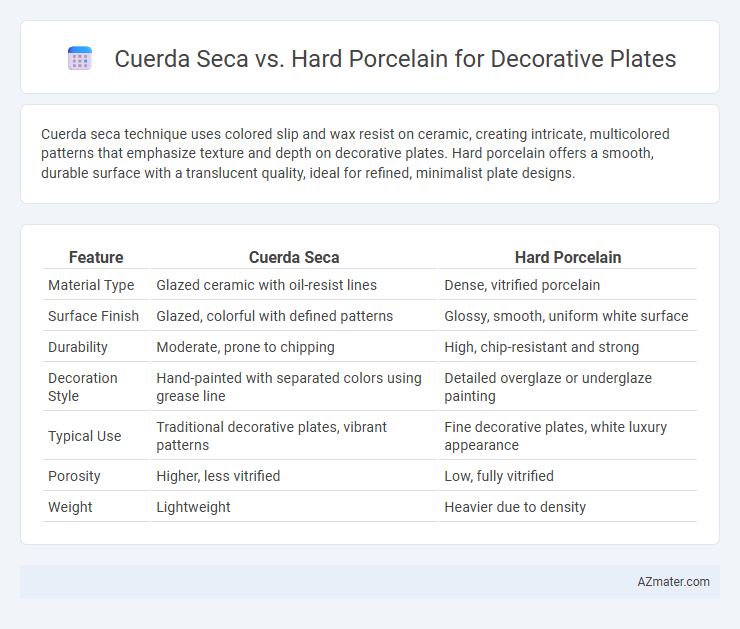Cuerda seca technique uses colored slip and wax resist on ceramic, creating intricate, multicolored patterns that emphasize texture and depth on decorative plates. Hard porcelain offers a smooth, durable surface with a translucent quality, ideal for refined, minimalist plate designs.
Table of Comparison
| Feature | Cuerda Seca | Hard Porcelain |
|---|---|---|
| Material Type | Glazed ceramic with oil-resist lines | Dense, vitrified porcelain |
| Surface Finish | Glazed, colorful with defined patterns | Glossy, smooth, uniform white surface |
| Durability | Moderate, prone to chipping | High, chip-resistant and strong |
| Decoration Style | Hand-painted with separated colors using grease line | Detailed overglaze or underglaze painting |
| Typical Use | Traditional decorative plates, vibrant patterns | Fine decorative plates, white luxury appearance |
| Porosity | Higher, less vitrified | Low, fully vitrified |
| Weight | Lightweight | Heavier due to density |
Introduction to Decorative Plate Techniques
Cuerda seca and hard porcelain represent two distinct decorative plate techniques with unique aesthetic and technical qualities. Cuerda seca, known for its bold, segmented designs created using oily resist lines, emphasizes vibrant, intricate patterns typically achieved through ceramic glazes fired at high temperatures. Hard porcelain, characterized by its dense, white, and translucent body, offers a smooth, delicate surface ideal for detailed painting and fine craftsmanship often found in high-end decorative plates.
Understanding Cuerda Seca: Process and Origins
Cuerda seca is a traditional decorative technique used in ceramic plate making, characterized by its use of oily resist lines to separate colored glazes and prevent them from mixing during firing, creating intricate, vividly colored patterns. Originating in the Islamic art of the 10th century and gaining prominence in Spanish and Mexican pottery, cuerda seca allows for detailed motifs that hard porcelain decoration methods, which often rely on smoother, more uniform surfaces, might not achieve as distinctly. While hard porcelain offers durability and a refined, glossy finish ideal for modern plates, cuerda seca stands out for its historical craftsmanship and richly textured, segmented designs that emphasize decorative artistry.
Hard Porcelain: Characteristics and History
Hard porcelain, known for its high density and durability, originates from 18th-century Europe and is composed primarily of kaolin, providing a translucent and glass-like finish. Compared to cuerda seca, which uses a resist technique for colorful patterns, hard porcelain offers a smoother surface ideal for intricate painting and long-lasting decoration. Its strength and non-porous nature make it a preferred material for decorative plates that require both elegance and resilience.
Visual Differences: Cuerda Seca vs Hard Porcelain
Cuerda Seca decorative plates showcase vibrant, segmented color areas outlined by thin black or dark brown lines created by a waxy resist technique, resulting in a distinctive mosaic-like appearance. Hard porcelain plates exhibit a smooth, glossy surface with intricate, finely detailed painted designs that often appear more uniform and polished compared to the textured look of Cuerda Seca. The visual contrast lies in Cuerda Seca's bold, outlined color separation versus hard porcelain's seamless, delicate brushwork and refined finish.
Color and Glazing Techniques Compared
Cuerda seca employs a traditional color separation technique using oily resist lines to create vibrant, distinct hues on decorative plates, resulting in sharp, multicolored designs with a matte or slightly textured finish. Hard porcelain typically features smooth, glossy glazing achieved through high-temperature firing, enhancing color depth and durability while offering a more uniform surface ideal for detailed, realistic pictorial decorations. The cuerda seca method emphasizes intricate, bold color contrasts within a more porous glaze, whereas hard porcelain prioritizes sleek finish and color brilliance through advanced glazing technologies.
Durability and Longevity Analysis
Cuerda seca and hard porcelain each offer distinct durability and longevity characteristics for decorative plates. Hard porcelain is highly resistant to chipping, scratching, and moisture, making it ideal for long-term display and functional use. Cuerda seca, while visually striking due to its intricate glaze separation technique, is more susceptible to wear and glaze cracking over time, requiring careful handling to maintain its decorative appeal.
Artistic Flexibility and Design Options
Cuerda seca technique offers greater artistic flexibility for decorative plates by allowing multiple colors to be separated with a greasy resist, enabling intricate, multi-hued designs without color mixing. Hard porcelain provides a smooth, durable surface ideal for detailed painting and glazing, but its design options are often limited by firing temperature constraints and fewer color layering possibilities. Artists seeking vibrant, complex patterns favor cuerda seca, while those prioritizing durability and fine detail may prefer hard porcelain.
Maintenance and Care Requirements
Cuerda seca decorative plates require gentle cleaning with a soft cloth to preserve their vibrant glazes and delicate patterns, avoiding harsh chemicals or abrasive materials that can damage the intricate designs. Hard porcelain plates offer higher durability and easier maintenance, as they are less prone to chipping and can be safely cleaned with mild detergents without risking surface damage. Choosing between cuerda seca and hard porcelain depends on balancing aesthetic preservation with the desired level of everyday care and handling.
Cost and Value Considerations
Cuerda seca technique decorative plates often entail higher production costs due to intricate hand-painting and the use of multiple glazes, which can increase their market value as artisan collectibles. Hard porcelain plates, known for their durability and smooth finish, generally have lower manufacturing costs and offer excellent value for everyday use without sacrificing elegance. Choosing between the two depends on prioritizing artistic craftsmanship and exclusivity versus cost-efficiency and practicality.
Choosing the Best Technique for Decorative Plates
Choosing between cuerda seca and hard porcelain for decorative plates depends on desired aesthetic and durability. Cuerda seca offers intricate, multicolored designs with a traditional, hand-painted feel, ideal for vibrant, detailed decoration, while hard porcelain provides a smooth, durable surface with fine translucency suited for minimalist or modern styles. Consider factors like firing temperature, finish quality, and design complexity to select the best technique for decorative plates.

Infographic: Cuerda seca vs Hard porcelain for Decorative plate
 azmater.com
azmater.com